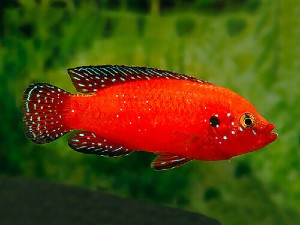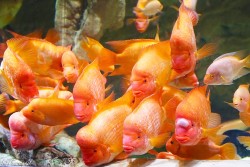Turkana Jewel Cichlid (Hemichromis exsul) CareSheet
 The Turkana Jewel Cichlid is a vibrant, unusual species that is tiny and one of the least aggressive in its genus!
The Turkana Jewel Cichlid is a vibrant, unusual species that is tiny and one of the least aggressive in its genus!The Turkana Jewel Cichlid (Hemichromis exsul) is a tiny cichlid that grows to a spectacular peach to ruby overall colour with numerous neon blue and blue-green spots, similar to its near cousins. This African species, which is native to Kenya's Lake Turkana, loves water conditions comparable to those seen in the New World (South and Central America). It is very quiet for a cichlid of its size (outside of mating season) and might perhaps be housed in a cichlid community setting in a large tank. Compare with Hemichromis lifalili species.
The Turkana Jewel Cichlid thrives in an aquarium with plenty of hiding places, such as clay pots, driftwood, and rock formations. It is unlikely to consume ornamental plants, although it is known to dig, therefore plants that adhere to driftwood and rockwork are advised. As previously said, this cichlid is relatively calm in comparison to many of its cousins, therefore it gets along well with other peaceful and semi-aggressive fish that are too big to be considered prey, such as Kribensis cichlids and bigger African Tetras. However, it may not be a suitable fit for normal community tanks with little fish like rasboras and tetras. During spawning, territoriality is usually at its height. The Turkana Jewel Cichlid should not be housed alongside dwarf shrimp or other tiny, sensitive invertebrates. If spawning is desired, other species should be kept to a minimum or avoided entirely unless the aquarium is large enough with enough of cover and decor.
The Turkana Jewel Cichlid is a fuss-free feeder. Dry, frozen, and live meaty items of high quality will all be welcomed. Vegetable matter is also necessary, which may be obtained by giving spirulina-rich meals or blanched fresh vegetables like spinach. This species should not be fed dry items entirely since quality and diversity are the keys to a diet that will guarantee that it maintains maximum health and color.
Requirements for keeping Hemichromis exsul
Temperature: 73° - 79° F
pH: 6.0 - 7.0
KH: 0 - 10 KH
Minimum tank size: 29+ gallons for a pair
Origin: Indigenous to Lake Turkana, Kenya
Average adult size: 4 inches

HEMICHROMIS EXSUL ! - a unique jewel cichlid from Lake Turkana
FAQ's
What is Hemichromis exsul?
Hemichromis exsul, also known as the jewel cichlid, is a species of freshwater fish native to rivers in West Africa. It is a brightly colored fish that derives its name from the shiny jewel-like spots that adorn its body.
Where does Hemichromis exsul live?
The native habitat of Hemichromis exsul is limited to river basins in Ghana and Cote d'Ivoire in West Africa. Its geographic range is quite small and fragmented.
What does Hemichromis exsul eat?
Hemichromis exsul is an omnivorous species that feeds on a variety of plant matter, insects, crustaceans and other small invertebrates. In captivity they can be fed a diet of commercial cichlid pellets supplemented with live or frozen foods.
How big does Hemichromis exsul grow?
In the wild, Hemichromis exsul typically reaches lengths of 7-8 cm. Captive specimens provided with ideal tank conditions may reach slightly larger sizes of up to 10 cm.
What is the lifespan of Hemichromis exsul?
The average lifespan of Hemichromis exsul in captivity is approximately 5-8 years. With excellent care, some individuals may live up to 10 years. Lifespans in the wild are likely shorter.
Is Hemichromis exsul easy to keep?
Yes, Hemichromis exsul is considered one of the easier West African cichlids to maintain. They are hardy, adaptable to a range of water conditions, and breed readily in captivity. Minimum tank size is 55 gallons.
Is Hemichromis exsul endangered?
While not currently considered endangered, Hemichromis exsul has a small native range and some populations are threatened by habitat loss. More research is needed to determine its full conservation status. Captive breeding programs may aid wild population preservation.



